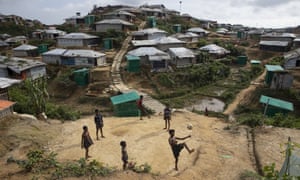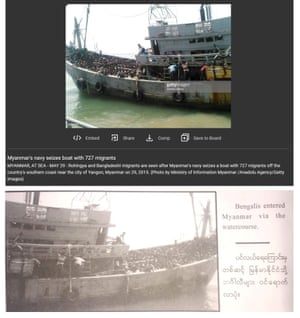Propaganda unit’s 117-page book contains pictures purportedly taken in Rakhine state that are really from Tanzania and Bangladesh

A new book on the Rohingya crisis written by Myanmar military propagandists uses fake photographs and a chilling rewriting of history in what appears to be an attempt to justify the killing of thousands of Rohingya over the last year in attacks by the army that the UN has condemned as genocide.
The 117-page book, published in July by the army’s department of public relations and psychological warfare, includes what it calls “documentary photos”. A Reuters investigation reveals that the provenance of three of the eight historical photographs contained in the book were faked.
One of the photographs shows a man standing over two bodies, wielding a farming tool. The text says the image shows Buddhists murdered by Rohingya during ethnic riots in the 1940s. But a Reuters examination of the photograph shows it was actually taken during Bangladesh’s 1971 independence war when hundreds of thousands of Bangladeshis were killed by Pakistani troops.

The photo is apparently intended to depict Rohingya arriving in Myanmar during the colonial era, which ended in 1948. Reuters determined the picture is in fact a distorted version of a colour image taken in 1996 of refugees fleeing the genocide in Rwanda.
The photograph was taken by Martha Rial for the Pittsburgh Post-Gazette. The newspaper did not immediately respond to a request for comment on the use of its photo.
Another picture, also printed in black and white, shows men aboard a rickety boat. “Bengalis entered Myanmar via the watercourse,” the caption reads.
Actually, the original photo depicts Rohingya and Bangladeshi migrants leaving Myanmar in 2015, when tens of thousands fled for Thailand and Malaysia. The original has been rotated and blurred so the photo looks grainy. It was sourced from Myanmar’s own Ministry of Information.

The 117-page “Myanmar Politics and the Tatmadaw: Part I” relates the army’s narrative of August last year when some 700,000 Rohingya fled Rakhine to Bangladesh, according to United Nations agencies, reporting mass killings, rape, and arson.
The book is on sale at bookstores across the commercial capital of Yangon.
On Monday, Facebook banned the army chief and other military officials accused of using the platform to “inflame ethnic and religious tensions”. The same day, UN investigators accused Senior General Min Aung Hlaing of overseeing a campaign with “genocidal intent” and recommended he and other senior officials be prosecuted for crimes against humanity.
In its new book the military denies the allegations of abuses, blaming the violence on “Bengali terrorists” it says were intent on carving out a Rohingya state named Arkistan.
Attacks by Rohingya militants calling themselves the Arakan Rohingya Salvation Army preceded the military’s crackdown in August 2017 in Rakhine state, in which the UN investigators say 10,000 people may have been killed. The group denies it has separatist aims.
The book also seeks to trace the history of the Rohingya – who regard themselves as native to western Myanmar – casting them as interlopers from Bangladesh.
